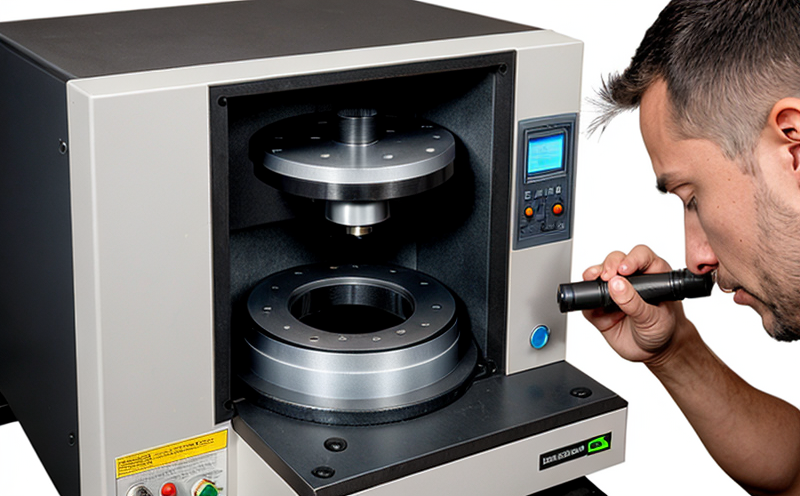ASTM E340 Macroetch Testing of Steel Bars and Forgings
The ASTM E340 standard is an essential tool for evaluating the microstructure and internal quality of steel bars and forgings. This macroetch testing method examines the surface finish of these materials to reveal grain size, segregation, and other imperfections that can affect mechanical properties and performance. The process involves careful preparation of the specimen, etching with specific reagents, and detailed visual inspection under magnification.
Macroetch testing is particularly critical for industries reliant on high-strength, high-quality steel components such as automotive, aerospace, and construction sectors. It ensures compliance with stringent quality control standards, thereby enhancing product reliability and safety. The test results provide valuable insights into the manufacturing process and material characteristics, enabling continuous improvement in production techniques.
The ASTM E340 method is based on etching the surface of the steel specimen to create a visible pattern that represents the grain structure. This pattern allows technicians to evaluate various features including grain size, banding, segregation, and other anomalies. The process requires precise control over etch time, temperature, and reagent concentration to ensure consistent results across different samples.
The significance of ASTM E340 testing lies in its role as a non-destructive inspection method that complements other mechanical tests like tensile strength or hardness measurements. By identifying potential flaws early in the production process, it helps prevent costly errors down the line and ensures adherence to industry standards such as ISO 9001.
One of the key aspects of ASTM E340 macroetch testing is proper specimen preparation. Cleanliness is crucial; any residual dirt or oil can interfere with the etching process and lead to misleading results. Specimens must also be oriented correctly for optimal visualization of their microstructure.
The etchant used in this test typically contains a mixture of nitric acid, alcohol, and water. The exact composition may vary depending on the type of steel being tested but always adheres closely to the guidelines provided by ASTM E340. After applying the etchant, the sample is carefully cleaned before drying.
Visual inspection follows immediately after etching, typically performed using low-power microscopes or stereomicroscopes. Technicians look for specific patterns indicative of various grain sizes and distributions. For instance, finer grains might indicate better mechanical properties while coarser ones could signal issues like overheating during manufacturing.
This testing procedure is vital not only for quality assurance but also for research purposes where understanding how different processing conditions influence microstructure formation can lead to innovation in materials science.
Understanding the significance of ASTM E340 macroetch testing helps stakeholders appreciate its importance in maintaining high standards within metallurgical and materials engineering disciplines. By employing this technique, manufacturers can achieve greater accuracy in assessing their products' quality while fostering advancements through ongoing research into material behavior under diverse conditions.
Why It Matters
The application of ASTM E340 macroetch testing is crucial because it directly impacts the reliability and performance of steel bars and forgings used in critical applications. In industries where structural integrity plays a vital role, such as aerospace or automotive manufacturing, even minor imperfections can have significant consequences.
- Ensures Safety: Identifying internal defects early allows manufacturers to take corrective actions before the product reaches end-users.
- Promotes Compliance: Meeting specified quality standards ensures that products meet regulatory requirements and industry best practices.
- Enhances Reputation: Consistently delivering high-quality products builds trust among customers and partners, leading to long-term business success.
For R&D teams focused on developing new materials or improving existing ones, ASTM E340 macroetch testing provides critical data that informs decision-making processes. It enables them to fine-tune production methods, optimize heat treatment cycles, and explore alternative alloy compositions more effectively.
From a procurement perspective, understanding the importance of this test ensures informed purchasing decisions. Suppliers who adhere strictly to ASTM E340 guidelines are less likely to provide substandard materials, reducing risks associated with poor quality control.
Applied Standards
The application of ASTM E340 macroetch testing is rooted in several key standards that guide its execution and interpretation. These include:
- ASTM E112 - Standard Practice for Estimating Grain Size from Metallographic Sections: This standard provides guidelines on how to measure grain size using a standardized scale.
- ASTM E456 - Terminology Relating to Quality and Statistic Control of Materials, Processes, and Products: It defines terms related to quality assurance practices applicable during ASTM E340 testing.
- ASTM E1128 - Practice for Metallographic Evaluation of Grain Growth in Aluminum Alloys: This practice describes procedures specifically relevant when dealing with aluminum alloys but also provides useful insights for steel samples.
These standards ensure that the results from ASTM E340 macroetch testing are consistent and comparable across different laboratories and regions. Compliance with these guidelines not only enhances accuracy but also fosters collaboration within the global metallurgical community.





